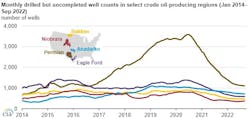EIA: Decline in DUC wells may limit US crude oil production growth
More wells were completed than were drilled in the US from July 2020 through September 2022 (the latest month for which data are available), according to the latest US Energy Information Administration (EIA) Drilling Productivity Report (DPR). As a result, the number of drilled but uncompleted wells (DUCs) fell to 4,333 as of September 2022, the fewest since at least December 2013, when EIA started estimating the number of DUCs. Fewer DUCs, along with natural gas pipeline constraints, could limit future US crude oil production growth, EIA said.
Historically, high or rising crude oil prices have encouraged well completions and crude oil production as well as increased drilling. In mid-2020, however, US crude oil production began to grow and the number of DUCs fell, indicating that producers were completing DUCs at a faster rate than they were drilling new wells. The significant decrease in the number of DUCs is a break from previous trends and may reflects producers’ caution about increasing capital expenditures needed to drill new wells after the disruption to the petroleum industry by the COVID-19.
As of Oct. 14, 2022, Baker Hughes reported 610 active oil rigs, which reflects a significant increase from 172 rigs on Aug. 14, 2020. However, the rig count since July has been relatively flat and has been historically low compared with other periods when front-month crude oil futures prices were near similar levels or even lower. Increased drilling typically lags 4-6 months behind a price increase. If drilling activity doesn’t increase, well completions and production may be limited as the number of DUCs fall, EIA said.
Permian
Of the seven major oil- and natural gas-producing regions in the US covered in EIA’s DPR, the Permian region accounts for about 60% of the crude oil total production. From January through September 2022, 3,904 wells were completed in the Permian region. During the same period, EIA estimates that 3,533 new wells were drilled in the Permian region. Because completions outpaced new wells drilled, the number of DUCs in the Permian region decreased. From July 2020 to September 2022, the number of DUCs in the Permian region fell from to 1,103 from 3,590.
Meantime, because most natural gas from the Permian region is produced along with, and as a result of, crude oil production, limitations on the ability to ship natural gas out of the Permian region, known as takeaway capacity, could limit future crude oil production growth in the region, EIA said.
